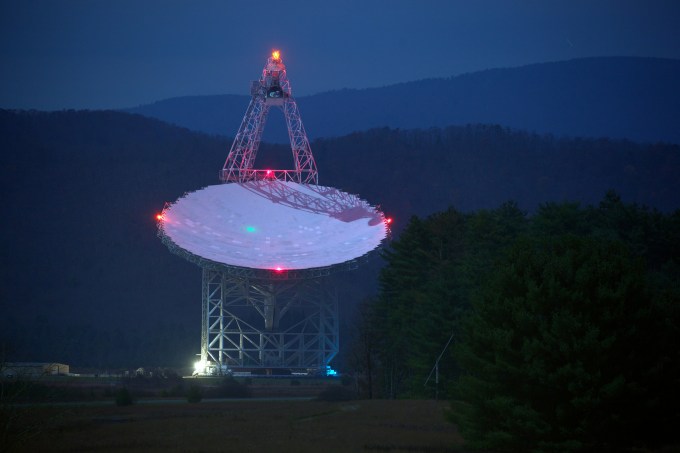Earlier this month billionaire investor Yuri Milner committed $100 million to initiate the most powerful search for intelligent life in the universe to date.
The project is called Breakthrough Listen and to those who are dedicated to this line of work, this money is a godsend, as funding for alien hunting has become harder and harder to find. Years of battling for funds, fighting critics about why we search for life, and hearing nothing but silence from our celestial neighbors makes this line of work trying.
This field of research is known as SETI, the Search for Extraterrestrial Intelligence. It searches specifically for life that is technologically savvy. SETI experiments are designed to detect electromagnetic waves (like radio waves or laser signals) that are not found naturally in the cosmos and would indicate a sophisticated civilization.
There are programs dedicated to SETI at a number of universities and research organizations all over the world, each employing a slightly different strategy in hopes of finding an intelligent neighbor. NASA once had its own $10 million-per-year SETI program, but Congress defunded it in back in 1993 and it hasn’t been revived since. Today, SETI work is done elsewhere at places like the SETI Institute, Berkeley, and Harvard, and is predominantly supported by private funds.
NASA does, however, invest millions of dollars into the search for life beyond Earth, just not the technologically savvy kind. Most notably, robotic Mars missions like the Phoenix Lander ($480 million) and the Curiosity Rover ($2.5 billion) have searched for liquid water and organic materials, important ingredients for life as we know it. The James Webb Space Telescope ($8.7 billion), scheduled to launch in 2018, will use spectroscopy to search for microbial life on planets outside of our solar system.
The search for microbial life continues to be a high priority for Congress and NASA, while the search for intelligent life is left fighting for scraps. Milner’s $100 million investment changes all of that for many SETI scientists.
With these missions, NASA’s not looking for little green men, but rather life in the most basic sense. The discovery of lifeforms, even a small single-celled microbe, elsewhere in our universe would be revolutionary.
The search for microbial life continues to be a high priority for Congress and NASA, while the search for intelligent life is left fighting for scraps. Milner’s $100 million investment changes all of that for many SETI scientists.
How Do We Search For Intelligent Life?
Imagine you are an alien on a distant planet looking at Earth and wondering, “Is there intelligent life there?” What hints are we giving to the cosmos that humans are, to our knowledge, intelligent technologically savvy beings?
Well, modern humans evolved about 200,000 years ago, but we’ve only been signaling our “intelligent” presence for less than a century. Human-constructed technology, like radio and TV, which emit electromagnetic signals is our dead giveaway.
Many believe that humanity’s first signal to the cosmos of our intelligent presence was Hitler’s speech for the opening of the 1936 Olympic games. Hitler’s broadcast was at a high enough frequency to penetrate Earth’s ionosphere (from which radio signals can be absorbed, reflected back down to Earth, or in this case refracted into space).
From there, it moved through the universe at the speed of light, decreasing in intensity as it traveled farther and farther away. Whether or not you, as an alien on a distant planet, could actually watch this broadcast depends on your distance from Earth, your position, and the sensitivity of your receiver.
Since then, humans have been signaling our existence to the universe through cell phone conversations, TV broadcasts, and satellite transmissions. Proof that Earth has intelligent life, just waiting to be detected by anyone within 100 light years of us with the right technology.
Here on Earth, we’re pointing our radio telescopes to the skies looking for these types of signals from other alien worlds. SETI experiments essentially involve finding better ways to eavesdrop on the universe.
Why Haven’t We Found Life Yet?
For starters, we haven’t always been entirely efficient at searching for life. We only started discovering Earth-like planets that scientists deem potentially “habitable” this year through the space-based telescope Kepler. This is crucial because these are the planets that, to our knowledge, are the best candidates for finding life outside of our solar system due to their size and their distance from their host star.
But we’ve been searching for intelligent life ever since noted astronomer Frank Drake conducted the first modern SETI experiment, known as Project Ozma, back in 1960. So where were we searching before we had Kepler? Well, scientists mostly studied the area by nearby stars and hoped for the best.
Breakthrough Listen hopes to solve the problems that plagued these previous SETI efforts. Now that we have a better idea of where to look, we can focus telescope time and scientists’ efforts accordingly. Breakthrough Listen will also cover ten times more of the sky than previous SETI efforts, scanning five times more of the radio spectrum. It will accomplish all of this 100 times faster than SETI efforts today. This is made possible by reserving more time on two of the world’s largest telescopes: the Green Bank Telescope in West Virginia, and the Parkes Telescope in Australia. We also now have the ability to search for laser transmissions with the relatively new Automated Planet Finder in California.

Green Bank Telescope in Green Bank, West Virginia
In addition to more time on telescopes, Seth Shostak, senior astronomer and director for SETI research at the SETI Institute, attributes this increased breadth of search to the ongoing improvements in digital technology. He says these improvements “allow you to simply look at more of the radio dial at a gulp, than you used to be able to. When Frank Drake did Project Ozma, he was looking at one spot on the radio dial at a time. What you really want to do is to look at all of these radio frequencies at once. Today we look at tens of millions of channels at once. Thanks to improvements in digital electronics, it will soon be hundreds of millions and maybe even a billion channels at once. What that means in terms of SETI is that it’s like giving Captain Cook a steamship, instead of the old colliers that he had, to search the south Pacific. He could go faster and make the discoveries more quickly.”

Captain James Cook, British explorer and captain in the Royal Navy. Cook made the first recorded European contact with Australia’s eastern coastline and the first circumnavigation of New Zealand.
To analyze this amount of data, the project will leverage the power of crowdsourcing. Breakthrough Listen will partner with Berkeley’s SETI@home community which consists of nine million volunteers who offer their spare computer time for data crunching. Milner has also stated that all of this information will be publicly available to encourage the public to join the search.
But efficiency and breadth aren’t the only issues in the search for intelligent life. Our solar system is 4.6 billion years old. We’ve really only been “listening” for intelligent life for the past 50 years. Many technological civilizations could have died out millions, or even billions, of years ago and we’ve completely missed them. Or perhaps they’re out there, but because of their distance from us their signals haven’t had time to reach us yet.
This perspective also helps us answer the question, “If aliens are out there, and they can detect our signals, why haven’t they reached out to us?” Neil deGrasse Tyson addressed this in his book, Space Chronicles.
“For all we know, the aliens may have tried to get in touch centuries ago and have concluded that there is no intelligent life on Earth. They would now be looking elsewhere. A more humbling possibility is that aliens did become aware of the technologically proficient species that now inhabits Earth, and drew the same conclusion.”
And of course, there’s the obvious possibility that we are, in fact, alone in the universe.
Listening Vs. Messaging
We are unintentionally “leaking” signals into space for aliens to detect all of the time. But there’s another aspect of SETI work known as Active SETI. This requires the use of our most powerful radio transmitters to send messages in the direction of our nearest stars and planets.
Not everyone likes this idea.
Stephen Hawking, for example, has cautioned humans on making their presence known to aliens. In his documentary Into the Universe, he’s said, “If aliens visit us, the outcome would be much as when Columbus landed in America, which didn’t turn out well for the Native Americans.”
Even so, we’ve sent out ten Active SETI interstellar radio messages to date. The most powerful Active SETI broadcast, and perhaps the most famous, is the Arecibo Message which was sent from Puerto Rico’s Arecibo Observatory in 1974. The three minute message, encoded as a binary string of 1’s and 0’s, contained a map of the solar system indicating which planet had sent the message, information about human DNA, and a graphic figure of a human, among other things.

The Arecibo message when arranged rectangularly as 73 rows and 23 columns. Color added to highlight its separate parts.
This message was aimed at a globular star cluster about 25,000 light-years away, which means they won’t receive our message for another 24,959 years. This also means it would take an additional 25,000 years to receive a reply. An impractical form of communication for sure, the Arecibo message was more of a technology demonstration than a serious attempt to make contact.
Still, if intelligent life is out there, it will probably be several light-years away and may not communicate the same way humans do. Attempting a conversation will require concerted thought and patience. How does one construct an understandable message to a lifeform completely unfamiliar with humans? Mathematics is often considered to be a universal language on Earth, could it be the same on another planet?
While much research has already been done on this topic, Milner hopes to push that work further through a second initiative, Breakthrough Message: a $1 million international competition to construct a digital message that best represents humanity and planet Earth. Whether or not this message will be sent has yet to be decided.
$100 Million Breath of Life
In an interview with Space.com earlier this year, Frank Drake said “The situation with SETI is not good. The enterprise is falling apart for lack of funding. While NASA talks about ‘Are we alone?’ as a number one question, they are putting zero money into searching for intelligent life. There’s a big disconnect there.”
Large radio telescopes are expensive to maintain and operate. The Green Bank Telescope in West Virginia, the world’s largest fully steerable radio telescope, costs around $8 million per year. The Lick Observatory, the first permanent mountaintop observatory in the world, runs at about $2.5 million per year. Both telescopes have been at risk of being completely defunded in the past few years.
The Parkes radio telescope in Australia also saw significant budget cuts just this past year.
At the same time, scientists are quickly discovering more and more planets that are the right size and right distance from their sun to be considered potentially habitable. These planets are quickly becoming our best bet at finding intelligent life.
On top of that, digital electronics and computers are following Moore’s law and becoming faster and cheaper. With the right funding, you can leverage this technology to search more of the sky more quickly than ever before.
For these reasons, Milner’s $100 million comes at a crucial and exciting moment. Breakthrough Listen is reserving significant time on each these telescopes over the course of the next decade, and in effect breathing back life into these programs.
We have yet to detect intelligent life elsewhere in the universe, and there’s no guarantee that this money and effort will enable us to find ET in the next ten years. It’s expensive, it’s not easy, and it’s probably going to take a while. But to many, the question “Are we alone,” is worth it all. As long as we have people like Yuri Milner to foot the bill, the search will continue.

